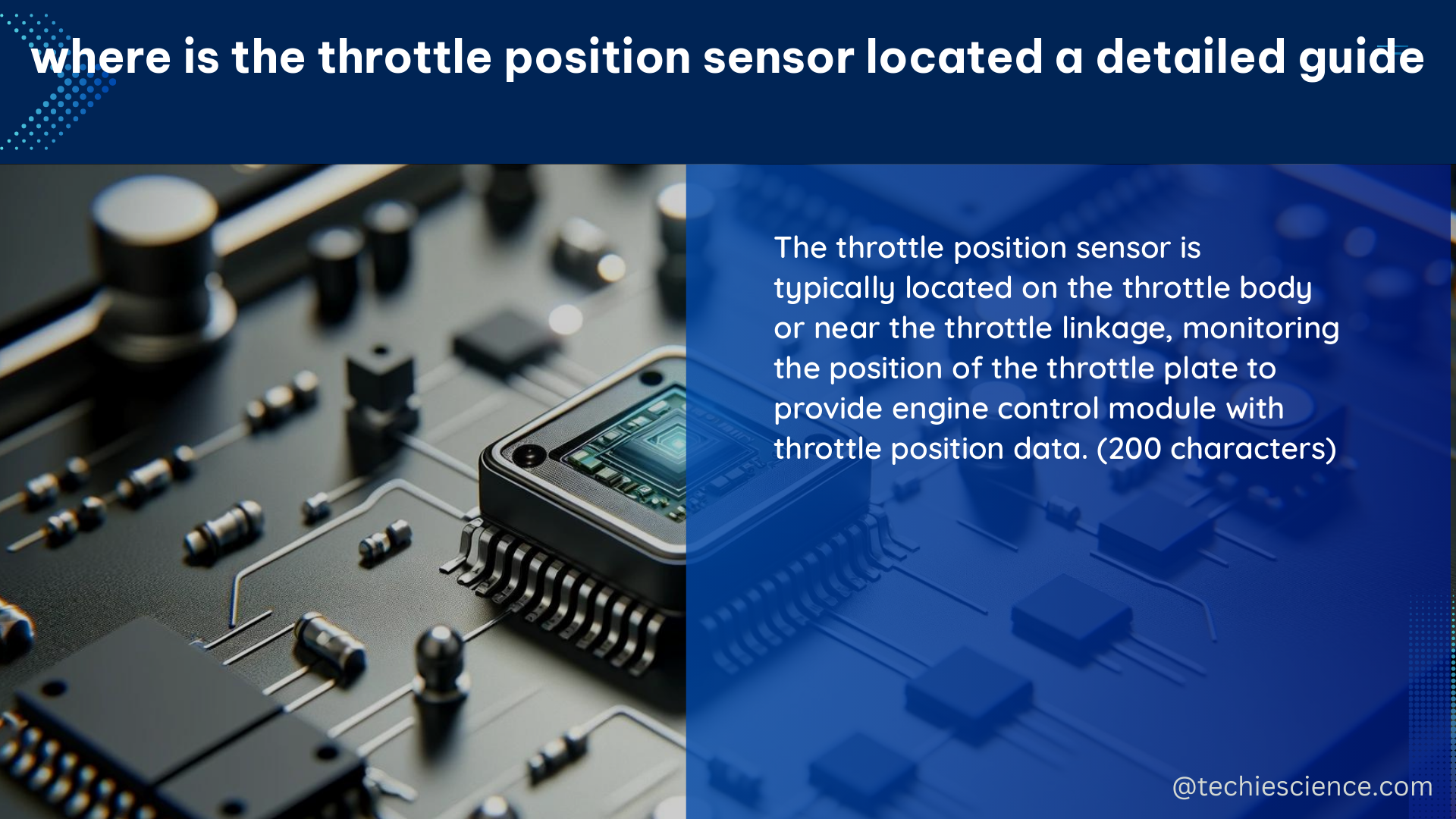The throttle position sensor (TPS) is a crucial component in modern vehicles’ engine management systems. It measures the position of the throttle valve and provides this information to the engine control unit (ECU), which uses it to adjust fuel injection accordingly. The TPS is typically located on the body of the throttle, near the air intake system.
Understanding the Throttle Position Sensor
The TPS is responsible for monitoring the position of the throttle valve, which controls the amount of air entering the engine. This information is essential for the ECU to accurately calculate the appropriate fuel delivery and ignition timing, ensuring optimal engine performance and efficiency.
There are two main types of TPS:
-
Potentiometer-based TPS: This type of TPS consists of a variable resistor connected to the throttle shaft. As the throttle is opened, the resistance across the potentiometer changes, providing a voltage signal to the ECU. The ECU then uses this signal to determine the position of the throttle and adjust fuel injection accordingly.
-
Hall effect-based TPS: This type of TPS uses a magnetic field to detect the position of the throttle. A small magnet is mounted on the throttle shaft, and as the shaft rotates, it passes over a Hall effect sensor, which generates a voltage signal. The ECU then uses this signal to determine the position of the throttle and adjust fuel injection accordingly.
Locating the Throttle Position Sensor

The TPS is typically located on the body of the throttle, near the air intake system. This placement allows the sensor to accurately measure the position of the throttle valve and provide the necessary information to the ECU.
To locate the TPS on your vehicle, follow these steps:
- Identify the throttle body: The throttle body is the component that houses the throttle valve and is typically located near the air intake system.
- Visually inspect the throttle body: Look for a small, rectangular or cylindrical sensor mounted on the throttle body. This is likely the TPS.
- Consult your vehicle’s service manual: The service manual will provide the exact location of the TPS, as well as detailed instructions for accessing and replacing the sensor.
Accessing and Replacing the Throttle Position Sensor
When replacing the TPS, it’s essential to follow specific steps to ensure proper installation and calibration. Here’s a step-by-step guide:
- Locate the TPS: Identify the location of the TPS on the throttle body, as described in the previous section.
- Disconnect the electrical connector: Carefully disconnect the electrical connector from the TPS, taking note of the wiring configuration.
- Remove the TPS: Unscrew or unbolt the TPS from the throttle body, taking care not to damage the sensor or the surrounding components.
- Install the new TPS: Carefully align the new TPS with the mounting points on the throttle body and secure it in place using the appropriate fasteners.
- Reconnect the electrical connector: Reconnect the electrical connector to the new TPS, ensuring a secure connection.
- Calibrate the TPS: Calibration is a crucial step to ensure the TPS is providing accurate readings to the ECU. Refer to your vehicle’s service manual for the specific calibration procedure, which typically involves the following steps:
- Set the voltmeter to the DC scale.
- Connect the voltmeter to the signal and ground wires of the TPS.
- Take a reading with the throttle closed.
- Open the throttle while monitoring the voltmeter reading.
- Check the transition between the minimum and maximum voltage. If there are any sudden jumps in the reading, this may indicate a problem with the sensor.
Maintaining the Throttle Position Sensor
Regular maintenance of the TPS is essential for optimal performance. Here are some tips for maintaining the TPS:
- Periodic inspection: Visually inspect the TPS for any signs of damage, such as cracks, corrosion, or loose connections.
- Cleaning: If necessary, clean the TPS using a suitable electrical contact cleaner. Avoid using abrasive cleaners or tools, as they can damage the sensor.
- Replacement: If the TPS is malfunctioning or showing signs of wear, replace it with a high-quality OEM or aftermarket part. Improper installation or the use of low-quality parts can cause the sensor to malfunction or fail prematurely.
Troubleshooting TPS Issues
If you notice any warning signs of a failing TPS, such as poor engine performance or a check engine light, address the issue promptly. A malfunctioning TPS can cause serious engine damage if left unaddressed. Some common symptoms of a failing TPS include:
- Rough idling
- Hesitation or stumbling during acceleration
- Reduced fuel efficiency
- Check engine light illumination
If you suspect a problem with the TPS, use a diagnostic tool to read any trouble codes and perform further testing to identify the root cause of the issue.
Conclusion
The throttle position sensor is a vital component in modern vehicles’ engine management systems. It’s typically located on the body of the throttle, near the air intake system, and comes in two main types: potentiometer-based and Hall effect-based. Proper installation, calibration, and regular maintenance are essential for optimal performance. By understanding the role and location of the TPS, you can ensure your vehicle’s engine management system is functioning at its best.
Reference:
- A Comprehensive Guide on Installing and Calibrating a Throttle Position Sensor
- Throttle Position Sensor: A Complete Guide
- Where is the Throttle Position Sensor Located?

The lambdageeks.com Core SME Team is a group of experienced subject matter experts from diverse scientific and technical fields including Physics, Chemistry, Technology,Electronics & Electrical Engineering, Automotive, Mechanical Engineering. Our team collaborates to create high-quality, well-researched articles on a wide range of science and technology topics for the lambdageeks.com website.
All Our Senior SME are having more than 7 Years of experience in the respective fields . They are either Working Industry Professionals or assocaited With different Universities. Refer Our Authors Page to get to know About our Core SMEs.